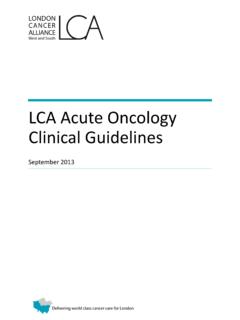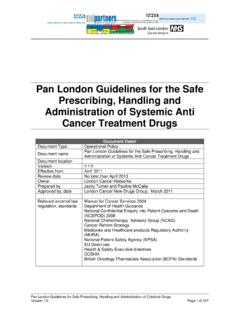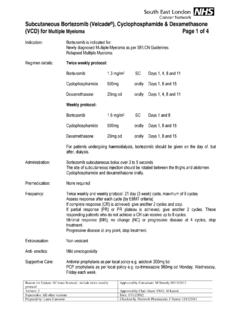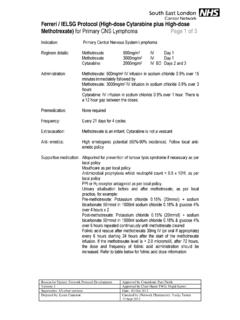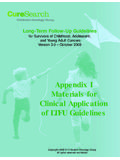Transcription of LCA Skin Cancer Clinical Guidelines
1 LCA skin Cancer Clinical Guidelines July 2014 LCA skin Cancer Clinical Guidelines 2 Contents Introduction and Background .. 4 Executive Summary .. 10 1 Referral Guidelines .. 11 Primary care to unit .. 11 Making urgent appointments .. 14 2 Investigation and Management of Suspected Melanoma .. 20 Investigations in secondary care .. 20 Management .. 22 3 Investigation and Management of Squamous Cell Carcinoma .. 28 Investigation in primary care .. 28 Investigation in secondary care .. 28 Treatment .. 28 Follow-up .. 29 Specialist palliative care (SPC) .. 30 4 Investigation and Management of Basal Cell Carcinoma .. 33 Diagnosis and investigation .. 33 Management .. 33 Recurrent (previously treated) BCC .. 34 Follow-up.
2 35 5 skin Cancer in Specific Anatomical Sites .. 36 Anal and perianal skin Cancer .. 36 skin Cancer of external female genitalia .. 36 Lymphoma arising within the skin .. 36 Head and neck skin cancers .. 37 Sarcoma involving skin .. 37 Urology/penile and skin Cancer .. 38 6 Children and TYA Pathways .. 39 Children below the age of 16 years .. 39 Teenagers and young adults .. 39 7 Pathology Guidelines for Diagnosis and Assessment of skin Cancer .. 40 Melanoma .. 40 Basal cell carcinoma (BCC) and squamous cell carcinoma (SCC) .. 41 Adnexal tumours .. 42 Merkel cell carcinoma .. 43 Tertiary review .. 43 CONTENTS 3 8 Radiotherapy .. 45 Radiotherapy for non-melanomatous skin Cancer .. 45 Investigations .. 45 Dose prescriptions.
3 46 Treatment of Bowen s disease, .. 46 Mycosis fungoides (cutaneous T-cell lymphoma) .. 47 Cutaneous angiosarcoma .. 47 Primary cutaneous B-cell lymphoma (PCBCL) .. 47 Lentigo maligna .. 48 Radiotherapy for melanoma .. 48 Merkel cell carcinoma .. 48 9 Imaging Guidelines for Diagnosis and Assessment of skin Cancer .. 51 Malignant melanocytic lesions .. 51 Non-melanoma skin Cancer .. 53 10 skin Cancer Survivorship Guidelines .. 54 Discuss a person s needs .. 55 Provide a treatment summary and care plan .. 55 Provide a main contact .. 55 Identify post-treatment symptoms .. 56 Provide support about day-to-day concerns .. 56 Talk about how you feel .. 56 Healthy 56 Self-managed follow-up .. 58 Encourage survivors to share their experience.
4 58 11 Psychological Support .. 60 Appendix 1: Urgent Suspected skin Cancer Referral Forms .. 62 Appendix 2: Total skin Electron Beam Therapy Treatments .. 65 Appendix 3: Advanced Cutaneous Malignant Melanoma Guidelines .. 66 Appendix 4: Follow-up of High-risk Cutaneous Melanoma in the UK .. 71 Appendix 5: Guidelines for the Management of Cutaneous T-cell Lymphoma .. 81 Appendix 6: Treatment of Teenagers and Young Adults .. 90 Appendix 7: Treatment of Children .. 93 Appendix 8: LCA Holistic Needs Assessment Tool .. 94 Appendix 9: LCA Key Worker Policy .. 95 Appendix 10: LCA Specialist Palliative Care Referral 97 Appendix 11: Contributing authors .. 100 LCA skin Cancer Clinical Guidelines 4 Introduction and Background The National Institute for Health and Care Excellence (NICE) published Improving Outcomes for People with skin Tumours including Melanoma1 in 2006 (Improving Outcomes Guidance IOG2) as part of the review of all tumour types, to implement The NHS Cancer Plan.
5 The IOG3 was updated in May 2010 for the management of low-risk basal cell carcinomas in the community. The IOG was published before the establishment of the London Cancer Alliance (LCA), and its recommendations were intended to assist the former Cancer networks, which were abolished in April 2013. However, the principles of the IOG are still relevant and should be observed by Trusts within the LCA. The major recommendations are as follows: There should be two levels of multidisciplinary teams (MDTs) local skin Cancer multidisciplinary teams (LSMDTs) and specialist skin Cancer multidisciplinary teams (SSMDTs). Where necessary, all health professionals who knowingly treat patients with any type of skin Cancer should be members of one of these teams, whether they work in the community or in the hospital setting.
6 This is the basis of successful management of skin Cancer within the LCA and is firmly adhered to. People with precancerous skin lesions should be either treated entirely by their GP or referred for diagnosis, treatment and follow-up by doctors working in the community who are members of the LSMDT/SSMDT. If there is any doubt about the diagnosis, people with precancerous lesions should be referred directly to their local hospital skin Cancer specialist, normally a dermatologist or plastic surgeon, who is a member of the LSMDT/SSMDT. Where appropriate, follow-up of these patients may be undertaken by their own GP. Patients with low-risk basal cell carcinomas (BCC) (see IOG update, 2010) should be diagnosed, treated and followed-up by doctors working in the community as part of the LSMDT/SSMDT (usually a GP with a special interest in dermatology), or a local hospital skin Cancer specialist, normally a dermatologist or plastic surgeon, who is a member of the LSMDT/SSMDT and to whom they have been directly referred.
7 Where there is doubt about the lesion being low or high grade, the patient should be referred directly to the LSMDT/SSMDT. The LCA defines a specialist in the diagnosis of skin malignancy as someone who has had recognised formal training, is a core member of the MDT and adheres to the rules of core membership. Pathology specimens should be sent to the core pathologist who is part of the same MDT. All patients with a suspicious pigmented skin lesion, with a skin lesion that may be a high-risk BCC, a squamous cell carcinoma (SCC) or a malignant melanoma (MM), or where the diagnosis is uncertain, should be referred to a doctor trained in the specialist diagnosis of skin malignancy, normally a dermatologist or plastic surgeon, who is a member of either an LSMDT or an SSMDT.
8 LSMDTs and SSMDTs should work to agreed protocols for: referral review of patient care by the multidisciplinary team management and audit of services for precancerous lesions and skin Cancer services. INTRODUCTION AND BACKGROUND 5 They should also ensure provision of ongoing education for all healthcare professionals about this very common group of tumours. The follow-up of patients after treatment should be jointly agreed between patient and doctor. After appropriate instruction, patients with low-risk disease will normally practise self-examination but follow-up may be offered in a community setting where appropriate. Patients with a high risk of recurrence of their skin Cancer or of new primary cancers should normally be followed-up in hospital but should still be instructed in self-examination and provided with written and photographic information.
9 All patients and carers should have access to high-quality information, in an appropriate style and format, about their condition and its management and about access to relevant support services. Protocols should be followed which cover the management of high-risk groups or those with special needs such as transplant patients, those with genetic predisposition to skin Cancer , patients with rare skin tumours (including cutaneous lymphoma), and children and young people. Epidemiology of skin cancers There are 60,000 new cases of skin cancers in England and Wales reported each year, which is probably an underestimate and does not include BCCs. One of the few studies published in the UK suggests that the true annual incidence could be over 125,000 new cases of n on-melanoma skin Cancer (NMSC) annually in England and Wales.
10 This would mean that a district general hospital serving a population of 250,000 would treat about 625 new cases per year and a typical general practice, serving a population of 10,000, would see about 25 new NMSC cases each year. Despite these limitations, Cancer registry data can be used to look at trends in incidence, mortality and survival, and variations in these by sex, age and region of the country. Malignant melanoma The term malignant melanoma is confusing. Melanoma, by definition, is a malignant skin lesion. There is no such entity as benign melanoma . Throughout the text of these Guidelines , the terms malignant melanoma and melanoma are interchangeable. Malignant melanoma (MM), although far less common than non-melanoma skin Cancer (NMSC) is the major cause of death from skin Cancer and is more likely to be accurately reported and diagnosed than NMSC.




